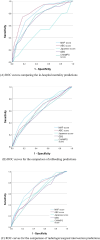Comparison and validation of several scoring systems for non-variceal upper gastrointestinal bleeding: a retrospective study
- PMID: 39537867
- PMCID: PMC11561243
- DOI: 10.1038/s41598-024-79643-1
Comparison and validation of several scoring systems for non-variceal upper gastrointestinal bleeding: a retrospective study
Erratum in
-
Author Correction: Comparison and validation of several scoring systems for non-variceal upper gastrointestinal bleeding: a retrospective study.Sci Rep. 2024 Dec 9;14(1):30428. doi: 10.1038/s41598-024-82370-2. Sci Rep. 2024. PMID: 39653696 Free PMC article. No abstract available.
Abstract
Various scoring systems have been developed to predict outcomes in patients with non-variceal upper gastrointestinal bleeding (NVUGIB). However, their accuracy remains unclear. This study aimed to compare and validate the predictive performance of several established scoring systems in patients with NVUGIB: Glasgow-Blatchford score (GBS) and the age, blood tests, and comorbidities (ABC), mental status-anesthesiologist score-pulse-albumin-systolic blood pressure-hemoglobin (MAP(ASH)), Japanese, and Charlson comorbidity index-in-hospital onset-albumin-mental status-Eastern Cooperative Oncology Group performance status-steroids (CHAMPS) scores. We retrospectively reviewed the records of 1,241 patients who presented to the emergency department with NVUGIB and subsequently required hospitalization. Each scoring system was evaluated for its ability to predict in-hospital mortality, rebleeding, and the need for radiological or surgical intervention. The ABC score showed the highest accuracy in predicting in-hospital mortality. The MAP(ASH) score was the most effective predictor of rebleeding and the need for interventions. Different scoring systems have been optimized for various clinical outcomes. The ABC score was the best for predicting mortality, whereas the MAP(ASH) score excelled in identifying rebleeding risks and intervention needs. The selection of an appropriate scoring tool based on specific clinical scenarios can improve patient management and resource allocation in NVUGIB.
Keywords: Mortality; Scoring systems; Upper gastrointestinal bleeding. Endoscopy.
© 2024. The Author(s).
Conflict of interest statement
Figures


References
-
- Laine, L. Upper gastrointestinal bleeding due to a peptic ulcer. N Engl. J. Med.375, 1198 (2016). - PubMed
-
- Lee, P. L. et al. Tranexamic acid for gastrointestinal bleeding: a systematic review with meta-analysis of randomized clinical trials. Am. J. Emerg. Med.45, 269–279 (2021). - PubMed
-
- Tielleman, T., Bujanda, D. & Cryer, B. Epidemiology and risk factors for upper gastrointestinal bleeding. Gastrointest. Endosc Clin. N Am.25, 415–428 (2015). - PubMed
-
- Gralnek, I. M. et al. Endoscopic diagnosis and management of nonvariceal upper gastrointestinal hemorrhage (NVUGIH): European Society of Gastrointestinal Endoscopy (ESGE) Guideline - Update 2021. Endoscopy. 53, 300–332 (2021). - PubMed
Publication types
MeSH terms
LinkOut - more resources
Full Text Sources
Medical
Research Materials
Miscellaneous

